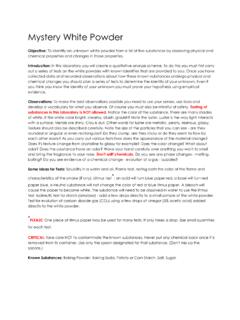Transcription of Chem 201 - Qualitative Analysis Lab
1 Chemistry 201 qualitative analysis Introduction General comments: It is always a good idea to use as few chemicals as possible; it makes sense both from consideration of lab safety and chemical waste disposal. Therefore, keep in mind that each of the chemical tests that are discussed below can be done with a few drops of solution. Remember that when using such small amounts, it is extremely important that the equipment that you use is very clean. If the equipment is dirty, the solutions will become contaminated, and it is possible that you will identify the contaminant rather than the unknown. To avoid cross contamination, make sure to recap reagent bottles with the original caps and to clean your droppers very well if they are to be reused.
2 Color of solution: The color of a solution can provide a clue to its chemical contents. Of the ions commonly encountered in this course, aqueous solutions of transition metal cations will often be colored since the valence d-electron energy levels of transition metal complexes can often absorb light in the visible region of the spectrum. This absorption of visible light causes the solutions to appear colored (see Figs. and in Silberberg). In contrast, cations of alkali (group 1A), alkaline earth (group 2A) metals and ammonium ions are colorless since the electrons of these ions do not absorb light in the visible region of the spectrum. A table of the colors of a selection of cations in aqueous solutions is given in the margin note area.
3 The color of a solution is a simple type of absorption spectroscopy. Flame test: The flame test is used in Qualitative Analysis to identify ions such as sodium, barium, potassium, calcium and others. In this test, the sample is vaporized in a flame and the flame becomes brightly colored as a result of light emitted from atoms and ions in excited energy states. In many cases, the color of the observed flame can be correlated to the chemical identity of the cations and anions in the solution (see Fig. , in Silberberg). A table of several such correlations is given in the margin note area. The flame test is a simple type of emission spectroscopy. The flame test is fast and easy but requires some practice to reliably produce and see the colors (some ions will be more intensely colored than others).
4 To carry out a flame test, you will use a clean inert wire and a clean watch-glass with a few drops of the aqueous solution. Clean a piece of nichrome wire (or paper clip) by first heating the wire in a hot Bunsen burner flame until it glows red hot. Dip the wire into a nitric acid (or hydrochloric acid) solution (see safety note in margin area), heat again, and then rinse with distilled water. Repeat these steps until the wire burns without color. To test an unknown, place some unknown Ion Solution Color Li+,K+, Na+, Ba2+, Ca2+, NH4+ Colorless Fe3+ Yellow Ni2+ Green Cu2+ Blue Ion Flame Color Li+ Red Na+ Yellow K+ Violet Ca2+ Dark Red Cu2+ Green Cl- Faint Green Ba2+ Green For the type of pH paper you will use: Red Acidic Orange Neutral Blue Basic solution onto a watch glass and hold it next to the air inlet at the bottom of your Bunsen burner.
5 Heat the wire in the flame and then plunge the hot wire into the solution in the watch glass. This will vaporize the solution, allowing it to be carried with the air into the flame producing a colored flame. If you have any questions regarding the test, ask your professor to demonstrate. Solubility: Many Qualitative Analysis schemes have been proposed that rely on the selective precipitation of specific cations and anions based on their solubilities. When two solutions are mixed, a compound formed from a cation in one solution and an anion in the second solution will precipitate if its concentration is higher than its solubility (see Section of Silberberg). Therefore, the solubility test can be conducted by mixing a few drops from two different solutions and noting whether a precipitate forms.
6 (The formation of a solid precipitate will be evident due to the increased turbidity of the mixture). For Qualitative Analysis , often only general trends in solubility need to be known. These trends can be summarized by a set of relatively simple rules, often referred to as the solubility rules and are given below. Also see table of Silberberg. (Solubility is defined as greater than mol/L at 25 C) Acidity: The pH test is used to determine the acidity of aqueous solutions. By placing a drop of a solution on pH indicator paper, the pH can roughly be determined. The color of the indicator paper after it is wetted with the test solution is correlated to pH (see text box in margin note area). For Qualitative Analysis , it is useful to divide the pH scale into at least three categories: strongly acidic (pH<3), neutral (pH~7), and strongly basic (pH>10).
7 Sometime the two additional categories, weakly acidic (3<pH<6) and weakly basic (8<pH<10), are also used. When a substance dissolves in water and causes an increase in the concentration of protons (H+), the substance is considered to be an acid. For classification purposes, we will define solutions with pH < 3 as strongly acidic. Examples of strong acids that you may encounter this semester include: HCl, H2SO4, HNO3 or H3PO4. Aqueous solutions of some metal ions also test acidic. The acidity is due to complexes that form between the metal ions and water. For instance, a M aqueous solution of Fe3+ will test strongly acidic. This is due to the following equilibrium, Fe3+(aq) + 6H2O(aq) [Fe(H2O)6]3+(aq) H+(aq) + [Fe(H2O)5OH]2+(aq) ANION +CATION COMPOUND THAT IS: Any +Alkali metal ions, or NH4+ Soluble NO3-, ClO4- +Any Soluble Cl-, Br-, I- +Any, except Ag+, Pb2+, Hg22+, Cu+ Soluble SO42- +Any, except Sr2+, Ba2, Pb2+.
8 Soluble OH ,S2- +Any, except alkali metal ions, NH4+, Sr2+. , Ca2+ , Ba2+ Insoluble PO43-, CO32-, SO32- +Any, except alkali metal ions, NH4+ Insoluble Other metal ions (such as Pb2+, Cu2+, Al3+ and Zn2+) will test only weakly acidic (3<pH<6). When a substance dissolves in water and causes an increase in the concentration of hydroxide ions (OH- ), the substance is considered to be a base. For classification purposes, we will define solutions with pH > 11 as strongly basic. Solutions with pH > 11 result from the presence of OH-, NH3, CO32-, or PO43-. Cations and anions that do not tend to form excess protons (H+) or hydroxide ions (OH-) will test neutral (pH 7). Solutions of salts formed by cations of groups 1A and 2A (such as Na+, K+, Ca2+, and Ba2+) and anions of strong acids (such as Cl , SO42 SCN-, and NO3 ) will be very close to pH 7.
9 Remember, the stronger the conjugate acid, the weaker the conjugate base. For example, since hydrochloric acid is a very strong acid, the conjugate base, Cl , has virtually no tendency to gain a proton. Additional information about acid-base chemistry can be found in Silberberg, sections and chapter 16. Gas-Producing Reactions: Some reactions form gaseous products that can easily be detected by observing bubble formation. For example, perhaps you have had the experience of adding vinegar (CH3 COOH) to baking soda (NaHCO3). This is an example of a gas-forming reaction. The resulting chemical reaction can written as, CH3 COOH (aq) + NaHCO3 (s) CO2 (g) + H2O (l) + CH3 COONa (aq) or alternately the reaction can be written in net ionic form as, HCO3- (aq) + H+ (aq) CO2 (g) + H2O (l) In addition to being a gas-forming reaction, you should recognize that this reaction is also an example of acid-base chemistry.
10 Predictably, this type of reactivity can be extended to the base, carbonate (CO32-), which can react with an acidic solution causing the formation of carbon dioxide bubbles due to the following reactions, CO32- (aq) + 2H+ (aq) HCO3- (aq) + H+ (aq) CO2(g) + H2O(l). A smelly example of a gas-producing reaction is an aqueous ammonia (also known as ammonium hydroxide) solution. Ammonia (with its characteristic odor) can be released by the equilibrium between a solution of ammonium hydroxide (solublized ammonia) and ammonia gas. NH4+ (aq) + OH- (aq) NH3 (g) + H2O (l). Complex ion formation: Many transition metals ions are known to form colored complexes when bonded with specific molecules or anions in an aqueous solution.




